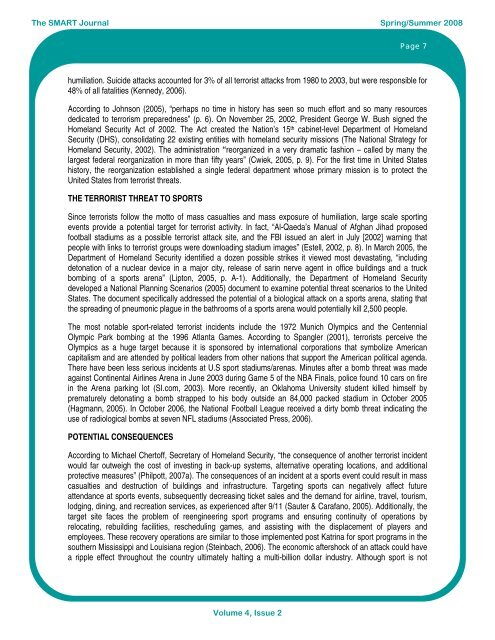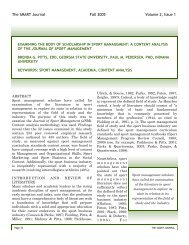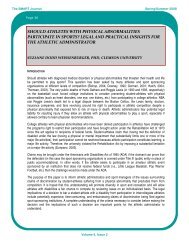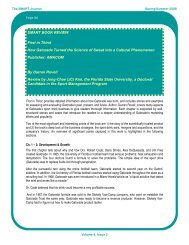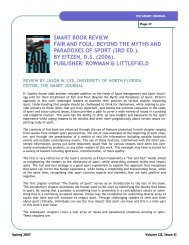Spring/Summer 2008 Volume 4, Issue 2 - The SMART Journal
Spring/Summer 2008 Volume 4, Issue 2 - The SMART Journal
Spring/Summer 2008 Volume 4, Issue 2 - The SMART Journal
You also want an ePaper? Increase the reach of your titles
YUMPU automatically turns print PDFs into web optimized ePapers that Google loves.
<strong>The</strong> <strong>SMART</strong> <strong>Journal</strong> <strong>Spring</strong>/<strong>Summer</strong> <strong>2008</strong><br />
Page 7<br />
humiliation. Suicide attacks accounted for 3% of all terrorist attacks from 1980 to 2003, but were responsible for<br />
48% of all fatalities (Kennedy, 2006).<br />
According to Johnson (2005), “perhaps no time in history has seen so much effort and so many resources<br />
dedicated to terrorism preparedness” (p. 6). On November 25, 2002, President George W. Bush signed the<br />
Homeland Security Act of 2002. <strong>The</strong> Act created the Nation’s 15 th cabinet-level Department of Homeland<br />
Security (DHS), consolidating 22 existing entities with homeland security missions (<strong>The</strong> National Strategy for<br />
Homeland Security, 2002). <strong>The</strong> administration “reorganized in a very dramatic fashion – called by many the<br />
largest federal reorganization in more than fifty years” (Cwiek, 2005, p. 9). For the first time in United States<br />
history, the reorganization established a single federal department whose primary mission is to protect the<br />
United States from terrorist threats.<br />
THE TERRORIST THREAT TO SPORTS<br />
Since terrorists follow the motto of mass casualties and mass exposure of humiliation, large scale sporting<br />
events provide a potential target for terrorist activity. In fact, “Al-Qaeda’s Manual of Afghan Jihad proposed<br />
football stadiums as a possible terrorist attack site, and the FBI issued an alert in July [2002] warning that<br />
people with links to terrorist groups were downloading stadium images” (Estell, 2002, p. 8). In March 2005, the<br />
Department of Homeland Security identified a dozen possible strikes it viewed most devastating, “including<br />
detonation of a nuclear device in a major city, release of sarin nerve agent in office buildings and a truck<br />
bombing of a sports arena” (Lipton, 2005, p. A-1). Additionally, the Department of Homeland Security<br />
developed a National Planning Scenarios (2005) document to examine potential threat scenarios to the United<br />
States. <strong>The</strong> document specifically addressed the potential of a biological attack on a sports arena, stating that<br />
the spreading of pneumonic plague in the bathrooms of a sports arena would potentially kill 2,500 people.<br />
<strong>The</strong> most notable sport-related terrorist incidents include the 1972 Munich Olympics and the Centennial<br />
Olympic Park bombing at the 1996 Atlanta Games. According to Spangler (2001), terrorists perceive the<br />
Olympics as a huge target because it is sponsored by international corporations that symbolize American<br />
capitalism and are attended by political leaders from other nations that support the American political agenda.<br />
<strong>The</strong>re have been less serious incidents at U.S sport stadiums/arenas. Minutes after a bomb threat was made<br />
against Continental Airlines Arena in June 2003 during Game 5 of the NBA Finals, police found 10 cars on fire<br />
in the Arena parking lot (SI.com, 2003). More recently, an Oklahoma University student killed himself by<br />
prematurely detonating a bomb strapped to his body outside an 84,000 packed stadium in October 2005<br />
(Hagmann, 2005). In October 2006, the National Football League received a dirty bomb threat indicating the<br />
use of radiological bombs at seven NFL stadiums (Associated Press, 2006).<br />
POTENTIAL CONSEQUENCES<br />
According to Michael Chertoff, Secretary of Homeland Security, “the consequence of another terrorist incident<br />
would far outweigh the cost of investing in back-up systems, alternative operating locations, and additional<br />
protective measures” (Philpott, 2007a). <strong>The</strong> consequences of an incident at a sports event could result in mass<br />
casualties and destruction of buildings and infrastructure. Targeting sports can negatively affect future<br />
attendance at sports events, subsequently decreasing ticket sales and the demand for airline, travel, tourism,<br />
lodging, dining, and recreation services, as experienced after 9/11 (Sauter & Carafano, 2005). Additionally, the<br />
target site faces the problem of reengineering sport programs and ensuring continuity of operations by<br />
relocating, rebuilding facilities, rescheduling games, and assisting with the displacement of players and<br />
employees. <strong>The</strong>se recovery operations are similar to those implemented post Katrina for sport programs in the<br />
southern Mississippi and Louisiana region (Steinbach, 2006). <strong>The</strong> economic aftershock of an attack could have<br />
a ripple effect throughout the country ultimately halting a multi-billion dollar industry. Although sport is not<br />
<strong>Volume</strong> 4, <strong>Issue</strong> 2


